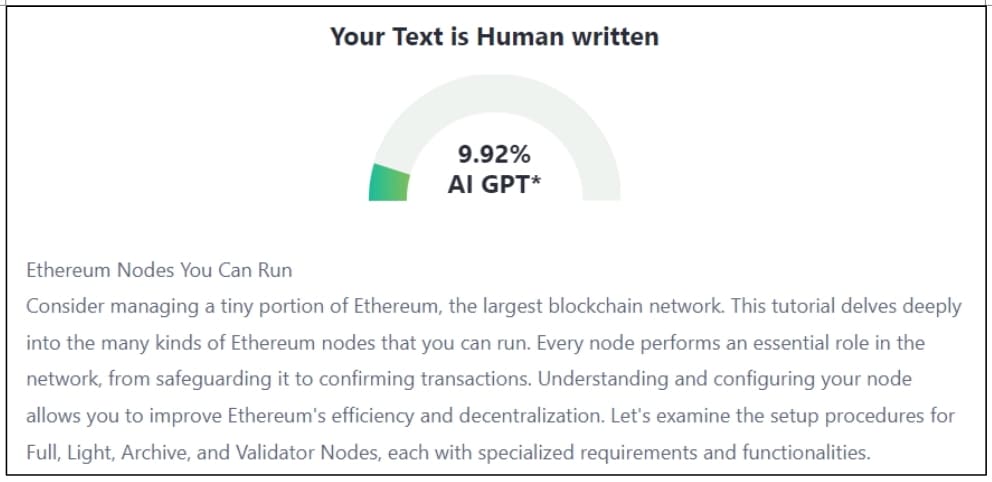Different Ethereum Nodes You Can Operate: A Comprehensive Guide

Consider managing a tiny portion of Ethereum, the largest blockchain network.
This article delves deeply into the many kinds of Ethereum nodes that you can run.

Every node performs an essential role in the network, from safeguarding it to confirming transactions. Understanding and configuring your node allows you to improve Ethereum’s efficiency and decentralization.
Let’s examine the setup procedures for Full, Light, Archive, and Validator Nodes, each with specialized requirements and functionalities.
Visit ethereumcode.app and explore more and in depth about investing in the market. Waiting for what? Register now and start learning.
Full Nodes
Operating a Full Node in the Ethereum network means holding a complete copy of the blockchain.
Every transaction ever made on Ethereum is stored and can be verified by your node.
Why do this? It’s about trust and security. By running a Full Node, you help keep Ethereum safe and decentralized.
Setting up a Full Node is easier than it sounds. It would help if you had some basic hardware: a decent computer with enough hard drive space (at least 500 GB), a solid internet connection, and some patience to download the entire blockchain.
The most popular software for this is Geth, which is straightforward to install and set up.
Once you’re up and running, your node will verify transactions and blocks. It’s like being a small but crucial part of the bank’s security system but for Ethereum.
Any new transactions or smart contracts will pass through you with the correct verification.
Have you ever considered how powerful that is?
Remember, running a Full Node means you can mine Ethereum, although it’s more competitive than ever. It’s not just about earning ether; it’s about supporting the ecosystem.
So, if you’re ready to play a direct role in the Ethereum network, setting up a Full Node might be your next big move. It’s challenging but rewarding, especially if you care about blockchain technology and its future.
Light Nodes
Light nodes provide a more accessible entry point for Ethereum participation without a complete blockchain history. This makes them ideal for personal use, such as managing wallets or small-scale apps.
They only download the essential information needed to validate transactions, which requires far less storage and computational power.
Think of a Light Node as a lightweight backpack instead of a packed suitcase. You have what you need to get by without the extra weight.
Setting up is simple, often just requiring a basic laptop and a stable internet connection. Clients like Parity (now OpenEthereum) offer user-friendly interfaces to get you started.
While you won’t directly mine Ethereum with a Light Node, you still play a crucial role.
Every transaction you make or verify helps keep the network fast and reliable. It’s like being a traffic officer, ensuring everything runs smoothly, but with much less equipment.
Running a Light Node can also be a learning step. It’s a practical way to understand how Ethereum works without the commitment of a Full Node.
Plus, it’s safer for those just dipping their toes into blockchain waters. You get to experience the technology and prepare to scale up to a more involved node later.
If you’re curious about Ethereum but not ready for the deep end, consider starting with a Light Node.
It’s a smart way to join the community, learn the ropes, and contribute without the heavy lifting. Why not try to see how it feels to be part of something big with just a small setup?
Archive Nodes
Archive Nodes take commitment to the next level in the Ethereum ecosystem. These nodes store everything: every transaction, every smart contract, and every state change since the blockchain’s inception.
Running an Archive Node is like keeping a detailed history book of Ethereum.
Why run an Archive Node? If you’re developing apps or need historical data for analysis, this node provides invaluable resources.
You have access to the entire blockchain history, which is crucial for developers testing old contracts or researchers analyzing the network’s evolution.
Setting up an Archive Node is a significant undertaking. It would help to have robust hardware, lots of storage (several terabytes), and a strong, steady internet connection.
It’s not for everyone, but for those who need deep insights and have the resources, it’s the ultimate tool.
They carry out every other function except mining, therefore forming an essential part of the Ethereum network. They support developers and analysts who must backtrack and understand the blockchain’s journey.
This deep dive into Ethereum’s past can reveal invisible trends and patterns in simpler setups.
Think about it—without Archive Nodes, our understanding of Ethereum’s functionality and evolution would be less precise.
They are the unsung heroes of the blockchain community, providing a foundation for development and innovation. Are you up for the challenge of running one? It might just set you apart in the world of blockchain technology.
Beacon Chain Validator Nodes
Ethereum’s future relies heavily on validator nodes, especially as the network moves toward Ethereum 2.0 and its proof-of-stake architecture.
These nodes are essential for processing transactions and building new blocks; they are proactive network validators, not just participants.
To run a Validator Node, you need to stake 32 ETH. This is your ticket into the network’s security system. It’s a significant investment but ties you directly to Ethereum’s success. Your role?
To vote on proposed blocks and ensure that no faulty or malicious blocks make it through.
Setting up a Validator Node involves more than hardware; it requires a strategic mindset.
A reliable computer, a secure internet connection, and a non-interruptive power supply would help. Client software like Prysm, Lighthouse, or Teku can help manage your node.
The stakes are high with Validator Nodes. If you act honestly and keep the network secure, you earn rewards.
However, you’ll lose some of your stake if you make a mistake or try to cheat. It’s like being part of the network’s police force, but you’re also being watched.
Validator Nodes represent a new era for Ethereum, focusing on sustainability and security. It’s an exciting time to get involved, especially if you believe in Ethereum and want to support its growth.
Are you ready to take on the responsibility and potentially reap the rewards?
Conclusion
Stepping into the world of Ethereum nodes is more than just a technical task; it’s a doorway to becoming part of a groundbreaking blockchain network.
Whether you choose a Full, Light, Archive, or Validator Node, each has its unique role and set of challenges.
By running any of these nodes, you contribute to the robustness and decentralization of Ethereum.
Ready to pick your path? Remember, each node type offers a different way to engage with and impact the Ethereum ecosystem.
Dive in, contribute, and possibly even profit from the ever-evolving landscape of blockchain technology.






